Moniek Bloks's Blog, page 30
December 4, 2024
OBITUARY: Princess Birgitta of Sweden
Princess Birgitta of Sweden was born on 19 January 1937 as the second child of Prince Gustaf Adolf, Duke of Västerbotten and Princess Sibylla of Saxe-Coburg and Gotha. Her elder sister is Princess Margaretha (born 1934), and her younger siblings are Princess Désirée (born 1938), Princess Christina (born 1943) and King Carl XVI Gustaf (born 1946).
Embed from Getty ImagesBirgitta and her sisters had no succession rights in Sweden. Sweden introduced absolute primogeniture in 1980, but only for the descendants of King Carl XVI Gustaf. When Birgitta’s father died in an aeroplane crash in 1947, her younger brother Carl Gustaf became Crown Prince at just nine months old. The four so-called Haga Princesses, after the palace where they lived, were initially educated privately. Birgitta later went on to study at the Gymnastics Central Institute, from which she graduated in 1958. During a language trip to Munich, she met her future husband, Prince Johann Georg of Hohenzollern, the third son of Frederick, Prince of Hohenzollern.
Embed from Getty ImagesIn late 1960, Birgitta and her sister Désirée visited the United States on the occasion of the first transatlantic flight by Scandinavian Airlines. The 10-day visit was widely covered by the press. Barely a month after their return to Sweden, the engagement between Prince Johann Georg and Princess Birgitta was announced. On 25 May 1961, the Lutheran Princess wed her Catholic prince in a civil ceremony in the Rikshall at Stockholm Palace. Despite it being a civil ceremony, Birgitta wore a wedding gown with a thirteen-foot train, a floor-length tulle veil and the Cameo tiara. The entire ceremony lasted just three minutes, and the newlyweds then went on a ride in an open carriage through Stockholm.8
Embed from Getty ImagesEmbed from Getty ImagesOn 30 May 1961, a Catholic ceremony was performed in Sigmaringen, where she was given away by her uncle Prince Bertil. This time she wore a white wedding dress with a diamond tiara from the Hohenzollern family.
Embed from Getty ImagesThe newlyweds settled in Munich, where Birgitta gave birth to three children: Carl Christian (born 1962), Désirée (born 1963) and Hubertus (born 1966). They separated in 1990 but continued to attend family events together. Birgitta ended up moving to Mallorca, Spain. She told Expressen that she spent a lot of time playing golf. About whether she would return to live in Sweden, she said, “No, it’s too dark and cold. Here the sun shines all the time, and if you have the opportunity to choose where you can live, it is definitely not stupid to be here. What should I do in the cold?”9
Embed from Getty ImagesPrince Johann Georg died in 2016, and Princess Birgitta died on 4 December 2024 in Mallorca.
The post OBITUARY: Princess Birgitta of Sweden appeared first on History of Royal Women.
Princess Birgitta of Sweden has died at the age of 87
The Swedish Royal House has announced that Princess Birgitta of Sweden has died at the age of 87.
She was the elder sister of King Carl XVI Gustaf of Sweden.
On the occasion of the death of Princess Birgitta, the King made the following statement:
“With great sadness, today I received the news that my sister, Princess Birgitta, has passed away. My sister was a colorful and forthright person who will be deeply missed by me and my family. Together with my entire family, today I send my condolences to Princess Birgitta’s children and grandchildren.”
Princess Birgitta was the widow of Prince Johann Georg of Hohenzollern, with whom she had three children.
The post Princess Birgitta of Sweden has died at the age of 87 appeared first on History of Royal Women.
December 3, 2024
Royal Wedding Recollections – The Duke of Brabant & Mathilde d’Udekem d’Acoz
On 10 September 1999, the Belgian royal court announced the engagement between Prince Philippe, the Duke of Brabant and Jonkvrouw Mathilde d’Udekem d’Acoz. Their wedding took place on 4 December 1999.
Before the wedding, Mathilde was created Duchess of Brabant and Princess of Belgium. This was published on 13 November and was effective from 4 December.
Embed from Getty ImagesThe civil wedding took place in the Brussels Town Hall, and the ceremony was held in French, Dutch and German. The couple then travelled to the Cathedral of St. Michael and St. Gudula for the religious ceremony.
Embed from Getty ImagesMathilde wore a wedding gown designed by Edouard Vermeulen, while Philippe wore the uniform of a Belgian Air Force colonel. Mathilde also wore her mother-in-law’s lace veil. Mathilde later said in an interview, “The celebration was really beautiful. The songs we had chosen in preparation, do you remember? And the texts. One of the girls who had speech therapy with me read a text. And we were surrounded by those who are close to our hearts.”
Embed from Getty ImagesMathilde wore Queen Elisabeth’s Art Deco Bandeau, which she had borrowed from her mother-in-law.
Embed from Getty ImagesDuring an interview, looking back on their wedding day, the now King Philippe said, “It was an extraordinary moment. We were living on cloud nine. The weather was beautiful, and everything was wonderful.”
The couple went on to have four children: Elisabeth (born 2001), Gabriel (born 2003), Emmanuel (born 2005) and Eléonore (born 2008). Philippe succeeded his father as King in 2013.
The post Royal Wedding Recollections – The Duke of Brabant & Mathilde d’Udekem d’Acoz appeared first on History of Royal Women.
December 2, 2024
The Wife of Duke Zhuang of Li – The Princess who was faithful to her husband who neglected her
The Wife of Duke Zhuang of Li was a princess of the state of Wei. Her name remains unrecorded, but her story lives on.[1] The Wife of Duke Zhuang of Li was in a loveless marriage and was neglected. Yet, The Wife of Duke Zhuang of Li remained faithful to her husband despite the obstacles.[2] Thus, many scholars have praised her for her dedication to a husband who did not value her.[3]
It is unknown when The Wife of Duke Zhuang of Li was born. She lived during the Spring and Autumn period, which lasted from 771 to 453 B.C.E. During this period, Chinese states were declaring their own independence from the ruling Zhou Dynasty to form their own dynasties.[4] The Wife of Duke Zhuang of Li was a princess of the state of Wei.[5] Her father was the Archer-Lord of Wei. Both her father’s and her names are unknown.
The Princess of Wei had an arranged marriage to Duke Zhuang of Li. Li was a small state that was next to Wei and is located in modern-day Shaanxi Province.[6] Once the Princess of Wei reached Li, Duke Zhuang of Li never received her, and he completely ignored her.[7] He had no concubines.[8] Therefore, historians believe that he had a preference for men and not women.[9] Her governess told the Princess of Wei to return home to her natal family.[10] However, the Princess of Wei refused. She wanted to fulfil her duties as a faithful wife.[11] She said, “Although [he] has not treated me as his wife, how can I depart from the duty of a faithful wife?”[12]
The Princess of Wei remained in Li.[13] She continued to be neglected and never even saw her husband, Duke Zhuang of Li.[14] Thus, it is clear that she had no children.[15] It is unknown when or how she died.[16]
The Wife of Duke Zhuang of Li has captured the sympathy of many writers and scholars.[17] There is even a poem written about her titled “Shi Wei” in The Book of Songs.[18] Even though Duke Zhuang of Li did not appreciate her and was cold to her, the Princess of Wei was willing to be a faithful wife to him. The Wife of Duke Zhuang of Li’s story has been seen as a model example to Confucian scholars.[19] Women must remain loyal to their husbands even if they are stuck in loveless marriages.[20]
Sources:
Cook, C. A. (2015). “Duke Zhuang of Li’s Wife”. Biographical Dictionary of Chinese Women: Antiquity Through Sui, 1600 B.C.E. – 618 C.E. (L. X. H. Lee, Ed.; A. D. Stefanowska, Ed.; S. Wiles, Ed.). NY: Routledge. pp. 15-16.
Eno, R. (2010). 1.7. Spring and Autumn China (771-453). Indiana University, PDF.
O’Hara, A. R. (1971). The Position of Woman in Early China: According to the Hieh Nü Chuan, “The Biographies of Chinese Women”. Taiwan: Mei Ya Publications.
Liu, X., Kinney, A. B. (2014). Exemplary Women of Early China: The Lienü Zhuan of Liu Xiang. United Kingdom: Columbia University Press.
[1] Cook, 2015
[2] Cook, 2015
[3] Cook, 2015
[4] Eno, 2010
[5] Cook, 2015
[6] Liu & Kinney, 2014
[7] Liu & Kinney, 2014
[8] Cook, 2015
[9] Cook, 2015
[10] Liu & Kinney, 2014
[11] Liu & Kinney, 2014
[12] Cook, 2015, p. 15; O’Hara, 1971 p. 109
[13] Liu & Kinney, 2014
[14] Liu & Kinney, 2014
[15] Cook, 2015
[16] Cook, 2015
[17] Cook, 2015
[18] Cook, 2015
[19] Cook, 2015
[20] Cook, 2015
The post The Wife of Duke Zhuang of Li – The Princess who was faithful to her husband who neglected her appeared first on History of Royal Women.
December 1, 2024
Princess Nanzi – The first woman in Chinese history to rule a state
Princess Nanzi was the first woman in Chinese history to ever rule a state.[1] She proved to be an intelligent and competent ruler.[2] She exercised her power effectively and successfully.[3] However, later chroniclers have depicted a negative image of her.[4] They even describe her as having an adulterous affair with her brother, Prince Zichao.[5] Yet, modern historians believe that the reason she has been harshly criticized is because they viewed her as a threat.[6] Her negative image was to warn future rulers that a woman should never hold power over a state again.[7]
Princess Nanzi was born in the fifth century B.C.E. She lived during the Spring and Autumn period, which lasted from 771 to 453 B.C.E. During this period, Chinese states were declaring their own independence from the ruling Zhou Dynasty to form their own dynasties.[8] She was a Princess of Song.[9] Her father was most likely Duke Ping of Song.[10] Her brother may have been Prince Zichao.[11]
Princess Nanzi married Duke Ling of Wei. Ancient Chroniclers have depicted him as an incompetent ruler who was not even interested in politics.[12] They also claimed he was a homosexual.[13] Chroniclers have praised him for appointing capable ministers.[14] Towards the end of his reign, he withdrew from state affairs.[15] He transferred his power and authority to his wife, Duchess Nanzi.[16]
Duchess Nanzi was the de facto ruler of Wei and the first woman to ever rule a Chinese state.[17] This is unusual because Duchess Nanzi was not the mother of an heir apparent.[18] Duchess Nanzi made many reforms that benefited Wei.[19] She continued to promote capable ministers.[20] She even met with Confucius.[21] Confucius even praised her intellect.[22]
Ancient chroniclers have stated that Duchess Nanzi was having an affair with her brother, Prince Zichao.[23] Historian Olivia Milburn stated that there is no historical evidence that Duchess Nanzi had an incestuous affair with her brother, Prince Zichao.[24] This was to depict her as being depraved.[25] Modern historians believe that chroniclers are trying to undermine her capabilities as a successful ruler because she dared to desire power.[26]
In 496 B.C.E., Crown Prince Kuaikui accused her of having an affair with Prince Zichao.[27] He even attempted to kill Duchess Nanzi.[28] However, the assassination attempt proved unsuccessful, and he fled Wei.[29] In 593 B.C.E., Duke Ling of Wei died. Duchess Nanzi installed Crown Prince Kuaikui’s son as Duke Chu of Wei.[30] In 480 B.C.E., Crown Prince Kuaikui overthrew his son, Duke Chu of Wei.[31] He became Duke Zhuang II of Wei. Duke Zhuang II executed Duchess Nanzi.[32]
Princess Nanzi was the first woman to rule a Chinese state.[33] She made many accomplishments that benefited Wei.[34] She proved to be a competent ruler.[35] She was praised by many people during her time, including Confucius.[36] Yet, she became known in history as depraved, adulterous, and incestuous and someone who caused the disruption of the Wei’s succession.[37] The negative image of Princess Nanzi proved that she was a threat to Confucian scholars.[38] The blackened image of Princess Nanzi was to teach women that they should never be heavily involved in politics.[39]
Sources:
Cook, C. A. (2015). “Nanzi, Wife of Duke Ling of Wei”. Biographical Dictionary of Chinese Women: Antiquity Through Sui, 1600 B.C.E. – 618 C.E. (L. X. H. Lee, Ed.; A. D. Stefanowska, Ed.; S. Wiles, Ed.). NY: Routledge. pp. 53-54.
Eno, R. (2010). 1.7. Spring and Autumn China (771-453). Indiana University, PDF.
McMahon, K. (2013). Women Shall Not Rule: Imperial Wives and Concubines in China from Han to Liao. NY: Rowman and Littlefield.
Milburn, O. (2010). “Gender, Sexuality, and Power in Early China: The Changing Biographies of Lord Ling of Wei and Lady Nanzi.” NAN NU — Men, Women & Gender in Early and Imperial China, 12(1), pp. 1-29. https://doi.org/10.1163/156852610X518183.
[1] Milburn, 2010
[2] Milburn, 2010; McMahon, 2013
[3] McMahon, 2013
[4] Milburn, 2010; McMahon, 2013
[5] Milburn, 2010; McMahon, 2013; Cook, 2015
[6] Milburn, 2010; McMahon, 2013
[7] Milburn, 2010; McMahon, 2013
[8] Eno, 2010
[9] Milburn, 2010
[10] Milburn, 2010
[11] Milburn, 2010; Cook, 2015
[12] Milburn, 2010
[13] Milburn, 2010
[14] Milburn, 2010
[15] Milburn, 2010
[16] Milburn, 2010
[17] Milburn, 2010
[18] Milburn, 2010
[19] Milburn, 2010; McMahon, 2013
[20] Milburn, 2010; McMahon, 2013
[21] Milburn, 2010; McMahon, 2013; Cook, 2015
[22] Milburn, 2010; McMahon, 2013
[23] Milburn, 2010; Cook, 2015
[24] Milburn, 2010
[25] Milburn, 2010
[26] Milburn, 2010; McMahon, 2013
[27] Milburn, 2010; Cook, 2015
[28] Milburn, 2010; Cook, 2015
[29] Cook, 2015
[30] Cook, 2015
[31] Cook, 2015
[32] Cook, 2015
[33] Milburn, 2010; McMahon, 2013
[34] Milburn, 2010; McMahon, 2013
[35] Milburn, 2010; McMahon, 2013
[36] Milburn, 2010; McMahon, 2013
[37] Milburn, 2010; McMahon, 2013; Cook, 2015
[38] Milburn, 2010; McMahon, 2013
[39] Milburn, 2010; McMahon, 2013
The post Princess Nanzi – The first woman in Chinese history to rule a state appeared first on History of Royal Women.
November 30, 2024
Book News Week 49
Book News Week 48 – 2 December – 8 December 2024
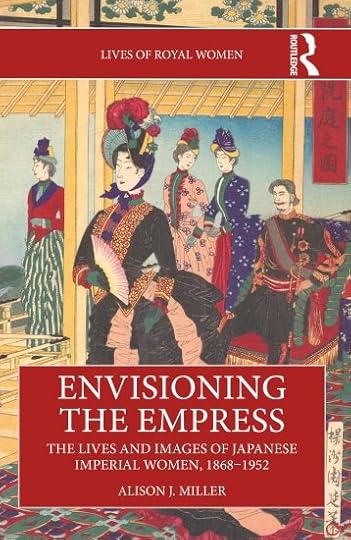
Envisioning the Empress: The Lives and Images of Japanese Imperial Women, 1868–1952 (Lives of Royal Women)
Paperback – 2 December 2024 (US & UK)
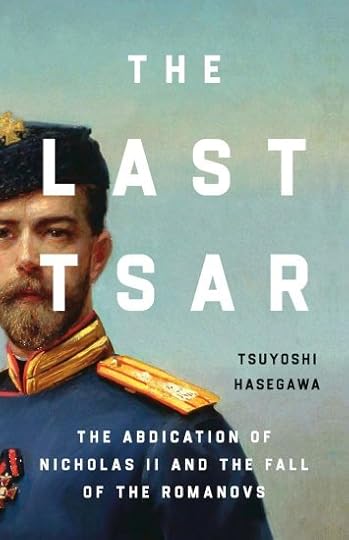
The Last Tsar: The Abdication of Nicholas II and the Fall of the Romanovs
Hardcover – 3 December 2024 (US) & 5 December 2024 (UK)
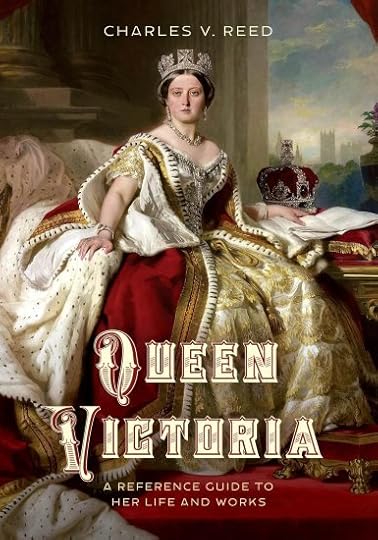
Queen Victoria: A Reference Guide to Her Life and Works (Significant Figures in World History)
Hardcover – 3 December 2024 (UK)
The post Book News Week 49 appeared first on History of Royal Women.
The Duchess of Sussex is a Princess – Here’s why
Here’s the deal: Meghan became royal by marriage when she married Prince Harry, the Duke of Sussex.
Her status is that of a Princess of the United Kingdom of Great Britain and Northern Ireland. Because she was not born royal, she was not entitled to be “Princess Meghan”. The late Diana, Princess of Wales, was commonly called “Princess Diana,” but she was not entitled to this either.
The same goes for The Princess of Wales (including when she was “just” the Duchess of Cambridge), the Duchess of Edinburgh, the Duchess of Kent and the Duchess of Gloucester.
The 1917 Letters Patent limits the title of Prince or Princess to the children of the sovereign, the grandchildren of the sovereign in the male line, and the eldest son of the eldest son of the Prince of Wales. In 2012, this was expanded to include all the children of the eldest son of the Prince of Wales, ensuring that both Princess Charlotte and Prince Louis were born Prince and Princess.
Does this make any of these women any less of a Princess? No. This was confirmed by Buckingham Palace when Lady Elizabeth Bowes-Lyon married the Duke of York (future King George VI). They released this statement: “In accordance with the settled general rule that a wife takes the status of her husband Lady Elizabeth Bowes-Lyon on her marriage has become Her Royal Highness the Duchess of York with the status of a Princess.”1
When Marie Christine von Reibnitz married Prince Michael of Kent in 1978, she became Princess Michael of Kent – sharing her husband’s status and taking on the feminine form.
The post The Duchess of Sussex is a Princess – Here’s why appeared first on History of Royal Women.
November 29, 2024
Wu Zetian: the Only Female Emperor of China Exhibition
The city of Leeuwarden in the north of the Netherlands is playing host to a unique new exhibition, “Wu Zetian: the Only Female Emperor of China,” in The Princessehof National Museum of Ceramics.
Wu Zetian was born around 624 as the daughter of Wu Shihuo, Duke Ding of Ying and Lady Yang. She was born into a rich family with connections to the ruling dynasty, and because of this, she was also rather well-educated. When she was 14 years old, she was taken to be an imperial concubine of Emperor Taizong of Tang, and she was given the title of cairen, which ranked as fifth in the Tang’s nine-rank system for imperial officials, nobles and consorts.
Emperor Taizong died in 649 and was succeeded by his son, Emperor Gaozong of Tang. As Wu did not have any children with the deceased Emperor, it was customary that she was to be confined to a monastic institution, and she was consigned to the Ganye Temple. However, she was brought back as a concubine by the new Emperor, who knew her from during his father’s lifetime.
By the early 650s, she had risen to the title of Zhaoyi, which was the highest ranking of the nine concubines of the second rank. In 652, she gave birth to her first son, and in 653, she gave birth to a second son. In 654, she gave birth to a daughter, who died not much later. Empress Wang was removed from her position as Empress. Wu was created Empress in her place. Empress Wang was eventually executed.
Click to view slideshow.In 655, Wu officially became the new Empress Consort, and her son was designated as crown prince. By 657, Empress Wu began avenging herself against all those who had opposed her accession. Several were executed and exiled. Even the former crown prince was placed under house arrest.
By 664, Empress Wu had so much power that it began to anger Emperor Gaozong. It was suggested to him that he depose her, and the edict was drawn up. Wu pleaded her case with the Emperor, and she managed to persuade him.
As Emperor Gaozong’s health began to decline, he considered having Empress Wu rule as regent. This never formally happened, but when he died in 683, the throne was taken by their son, now Emperor Zhongzong. However, she retained power as Empress Dowager. Emperor Zhongzong reigned for just six weeks, as his mother had him deposed, and she made her youngest son Emperor Ruizong. It was Wu who held power now.
By 690, Wu was set to become Empress Regnant of the newly proclaimed Zhou dynasty, despite the fact that women were barred from the throne. She took the throne later that year and immediately faced the issue of succession. She created the former Emperor Ruizong crown prince. Just three years later, the Crown Princess was accused of using witchcraft, and she was executed. Ruizong did not dare to speak of her for fear of being next.
Wu reigned until her death on 16 December 705.
Click to view slideshow.The items in the exhibition are loans from several international museums and include items from the tomb of Wu’s daughter-in-law, who was posthumously known as Empress Ai. You can also see replicas of the tomb murals from the tomb of Wu’s granddaughter, Li Xianhui (Princess Yongtai). Wu Zetian’s own tomb remains sealed with all its treasures inside.
The exhibition is absolutely wonderful. It not only shows Wu Zetian’s time in a global context with a grand mural but also focuses on her world by showing how the hierarchy worked. The items on display may be small in some cases, but they are significant and valuable. I especially liked the beautiful hairpins from a Tang Dynasty tomb and the rubbing made of a text said to have been written by Wu Zetian.
The exhibition can easily be followed if you don’t speak Dutch, as all of the information is also in English. Unfortunately, the accompanying publication is not available in English.
Plan your visit here. There is a supplement for Museum Card holders.
The post Wu Zetian: the Only Female Emperor of China Exhibition appeared first on History of Royal Women.
November 28, 2024
Empress Eugenie’s Bow Brooch
Empress Eugenie’s Bow Brooch was made in 1855 by the French jeweller François Kramer for Empress Eugenie, the consort of Emperor Napoleon III.
The original brooch consisted of only the diamond bow. Empress Eugenie asked the jeweller to make it into a larger stomacher, and the fringes and tassels were added.
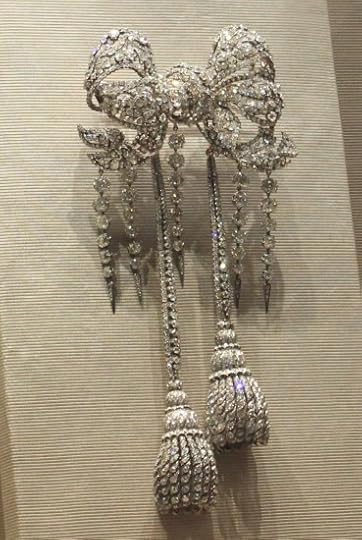 Photo by Moniek Bloks
Photo by Moniek BloksThe bow brooch was left behind in France when Eugenie and Napoleon were exiled in 1871, and it was sold at auction by the government in 1887. A French jeweller named Emile Schlesinger bought it for 42,000 francs, but he actually bought it for Caroline Schermerhorn Astor. The bow brooch remained with the Astor family for the next 100 years.
Embed from Getty ImagesIt was again offered for sale in 2008 at Christie’s in New York, but the sale was cancelled following a legal dispute. However, the Friends of the Louvre wanted the piece for the Louvre Museum, and a private sale was arranged. This means that Empress Eugenie’s Bow Brooch is now on display at the Louvre.1
The post Empress Eugenie’s Bow Brooch appeared first on History of Royal Women.
November 26, 2024
Eleanor of Austria – A “good and obedient woman” (Part four)
Eleanor and Francis had no children together but she became a stepmother to the children from his first marriage to Claude of France. She was particularly close to his eldest son, also named Francis, and was heartbroken when he died in 1536. While she was kept informed of her daughter’s health and education, she was desperate to be reunited with her and made several attempts to do so. She also tried to promote a French match for her as this would bring her closer to her mother. Indeed, she had been betrothed to Dauphin Francis by the Treaty of Madrid. However, Maria had been only nine at the time, and any official wedding was still a long way off. The death of the dauphin in 1536 put a stop to Eleanor’s hopes.
She also received portraits of Maria, and after receiving a new one in 1542, she wrote to Maria, “I rejoiced greatly, my daughter, with your painted portrait, for I cannot see the real one. Please, God, that this will happen one day, with your contentment, which will also be mine.”1 As Maria reached a marriageable age, Eleanor felt it was her motherly duty to see her daughter settled, and she desperately wrote to her sister Catherine, to talk to her husband, King John, to allow Maria to come to France. She also wrote to Maria asking her not to consent to anything less than being allowed to go to France with a full dowry. Once again, John refused to let Maria go, and he promised to marry her off quickly and as well as possible. Despite everything Eleanor had tried to do, Maria was effectively a stranger to her now. In 1544, Maria was created Duchess of Viseu in her own right, with the appropriate income.2
At the end of 1546, it appeared that the health of King Francis was in decline. Shortly before his death, he told his son, making “very long and affectionate remarks in favour of the Queen, so that he must have received her well, knowing that he had treated her too badly and without what she would have deserved, for having always been a good and very obedient woman to him.”3 Eleanor was not present when he died as she had not been aware of the seriousness of his illness. He died on 31 March 1547 and Eleanor learned of his death on 2 April. Once again, Eleanor was a dowager Queen, and this time, she had no blood connection to the family. The matter of her dowry was settled relatively quickly, and Eleanor stayed away from the subsequent coronation of the new King. In 1548, she chose to return to her birthplace – Brussels – where she was welcomed warmly by her sister, Mary. She never returned to France.
 Eleanor as dowager Queen of France as portrayed in Carlos, Rey Emperador (2015)(Screenshot/Fair Use)
Eleanor as dowager Queen of France as portrayed in Carlos, Rey Emperador (2015)(Screenshot/Fair Use)She again tried to be reunited with Maria, but as a dowager Queen, she had less influence than before. In 1552, she wrote to King John and implored God not to let her leave this life without seeing Maria again.4 Eleanor returned to Castile, but even there, Maria was not allowed to join her. She would be allowed to come to Portugal, but it would be inappropriate for Maria to travel to Castile.
However, Maria now also wished to see her mother despite her brother’s attempt to persuade her. She had renounced all possibilities of a marriage, forcing her brother to make another decision. She “decided to remain single and in the kingdom, in the midst of her friends, her books and the poor, devoting herself from now on to the sciences and arts, to charitable works and religious care.”5
At last, in April 1557, he decided to let Maria join her mother in Castile. Eleanor’s brother, Charles V, wrote letters of thanks to King John and Queen Catherine and shared the good news with Eleanor. Her departure was announced for 15 June, but then King John died suddenly. Maria changed her mind and refused to leave Portugal. The new King was Maria’s great-nephew, King Sebastian I, who was just three years old.
Eleanor was hurt and confused by Maria’s change of heart, but Maria wrote back that she feared that King John’s death would mean that she would not be allowed to return to Portugal and that she might face financial difficulties in Castile. However, she offered to spend several days with her mother on a pilgrimage to Our Lady of Guadalupe. It seemed like any permanent move was entirely off the table. Time passed as Maria refused to travel in the winter, and Eleanor offered to travel to Badajoz, which was not far from the border. Finally, at the end of 1557, Eleanor set off towards Badajoz with her sister Mary.
Eleanor and Mary arrived first, on 23 December 1557, and she waited anxiously for Maria to arrive. She finally arrived on 18 January 1558. One chronicler wrote, “It is not easy to describe the tears of joy that were shed on both sides: the Queen of France (Eleanor) admiring her daughter, and the Queen of Hungary (Mary) admiring her niece, who by her presence and appearance was dignified, serious in her words and modest with the natural grace and pleasantness of her person; the Queen of Hungary was spellbound, even though she lacked the bond of blood.”6
The festivities of the reunion lasted for 20 days while Eleanor tried to convince her daughter to come live in Castile with her. It was written that “she wanted nothing more in this life than to be comforted by her company.”7 Nevertheless, Maria remained steadfast in her determination to return to Portugal. On 7 February 1558, Maria left Badajoz and returned to Portugal.
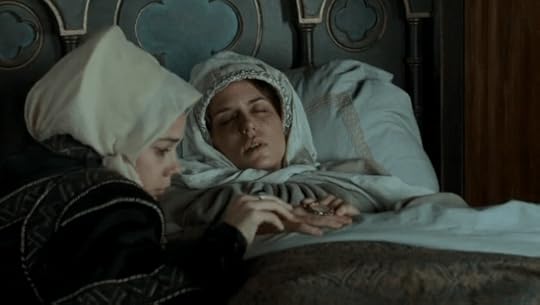 The death of Eleanor as portrayed in Carlos, Rey Emperador (2015)(Screenshot/Fair Use)
The death of Eleanor as portrayed in Carlos, Rey Emperador (2015)(Screenshot/Fair Use)Deeply upset at being separated from her daughter again, Eleanor set off to Guadalajara a few days later with Mary. Just a little while later, she was forced to stop at Talaveruela after a severe asthma attack. She became ill with a high fever and violent cough. She died on 18 February as her brother Charles arrived just in time to say goodbye. She had remained lucid until the end and asked to be buried in a modest ceremony. Her body now rests in the El Escorial.
The post Eleanor of Austria – A “good and obedient woman” (Part four) appeared first on History of Royal Women.



